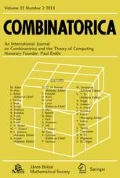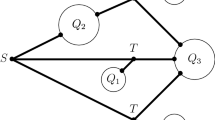Abstract
A 1-factor in an n-vertex graph G is a collection of \(\frac{n}{2}\) vertex-disjoint edges and a 1-factorization of G is a partition of its edges into edge-disjoint 1-factors. Clearly, a 1-factorization of G cannot exist unless n is even and G is regular (that is, all vertices are of the same degree). The problem of finding 1-factorizations in graphs goes back to a paper of Kirkman in 1847 and has been extensively studied since then. Deciding whether a graph has a 1-factorization is usually a very difficult question. For example, it took more than 60 years and an impressive tour de force of Csaba, Kühn, Lo, Osthus and Treglown to prove an old conjecture of Dirac from the 1950s, which says that every d-regular graph on n vertices contains a 1-factorization, provided that n is even and \(d \geqslant 2\left[ {\frac{n}{4}} \right] - 1\). In this paper we address the natural question of estimating F(n, d), the number of 1-factorizations in d-regular graphs on an even number of vertices, provided that \(d \geqslant \left[ {\frac{n}{2}} \right] + \varepsilon n\). Improving upon a recent result of Ferber and Jain, which itself improved upon a result of Cameron from the 1970s, we show that \(F\left( {n,\,d} \right) \geqslant {\left( {\left( {1 + o\left( 1 \right)} \right)\frac{d}{{{e^2}}}} \right)^{nd/2}}\), which is asymptotically best possible.
Similar content being viewed by others
References
N. Alon and S. Friedland: The maximum number of perfect matchings in graphs with a given degree sequence, Electron. J. Combin.15 (2008).
N. Alon and J. Spencer: The Probabilistic Method, 3rd ed., John Wiley and Sons (2008).
L. M. Bregman: Some properties of non-negative matrices and their permanents, Sov. Mat. Dokl.14 (1973), 945–949.
P. J. Cameron: Parallelisms of Complete Designs, London Math. Soc. Lecture Note Ser. 23., Cambridge Univ. Press, Cambridge (1976).
B. Csaba, D. Kühn, A. Lo, D. Osthus and A. Treglown: Proof of the 1-factorization and Hamilton decomposition conjectures, Mem. Amer. Math. Soc.244 (2016), monograph 1154.
D. Dubhashi, D. A. Grable and A. Panconesi: Near-optimal, distributed edge colouring via the nibble method, Theoret. Comput. Sci.203 (1998), 225–252.
G. Egorychev: The solution of the Van der Waerden problem for permanents, Dokl. Akad. Nauk SSSR258 (1981), 1041–1044.
D. Falikman: A proof of the Van der Waerden problem for permanents of a doubly stochastic matrix, Mat. Zametki29 (1981), 931–938.
A. Ferber and V. Jain: 1-factorizations of pseudorandom graphs, arXiv preprint arXiv:1803.10361 (2018).
A. Ferber, M. Krivelevich and B. Sudakov: Counting and packing Hamilton l-cycles in dense hypergraphs, J. Comb.7 (2016), 135–157.
A. Ferber, E. Long and B. Sudakov: Counting Hamilton decompositions of oriented graphs, Int. Math. Res. Not. IMRN22 (2018), 6908–6933.
D. Gale: A theorem on ows in networks, Pacific J. Math.7 (1957), 1073–1082.
R. Glebov, Z. Luria and B. Sudakov: The number of Hamiltonian decompositions of regular graphs, Israel J. Math.222 (2017), 91–108.
P. Hall: On representatives of subsets, J. Lond. Math. Soc.1 (1935), 26–30.
W. Hoeffding: Probability inequalities for sums of bounded random variables, J. Amer. Statist. Assoc.58 (1963), 13–30.
P. Keevash: Counting designs, eprint arXiv:1504.02909 (2015).
T. P. Kirkman: On a problem in combinations, Cambridge and Dublin Math. J.2 (1847), 191–204.
M. Kwan: Almost all Steiner triple systems have perfect matchings, eprint arXiv:1611.02246 (2016).
N. Linial and Z. Luria: An upper bound on the number of Steiner triple systems, Random Structures Algorithms43 (2013), 399–406.
E. Lucas: Recreations mathematiques, Vol. 2., Gauthier-Villars (1883) 161–197.
E. Mendelsohn and A. Rosa: One-factorizations of the complete graph - a survey, J. Graph Theory9 (1985), 43–65.
L. Perkovic and B. Reed: Edge coloring regular graphs of high degree, Discrete Math.165/166 (1997), 567–578.
V. Rödl: On a packing and covering problem, European J. Combin.6 (1985), 69–78.
H. J. Ryser: Combinatorial properties of matrices of zeros and ones, Canad. J. Math.9 (1957), 371–377.
E. Shamir and B. Sudakov: Two-Sided, Unbiased Version of Hall’s Marriage Theorem, Amer. Math. Monthly124 (2017), 79–80.
V. G. Vizing: On an estimate of the chromatic class of a p-graph, Diskret. Analiz.3 (1964), 25–30.
W. D. Wallis: One-factorization of complete graphs, Contemporary Design Theory: A Collection of Surveys (1992) 593–631.
Acknowledgments
The first author is grateful to Kyle Luh and Rajko Nenadov for helpful discussions at the first step of this project. We would also like to thank the anonymous referees for a very thorough reading of the manuscript and numerous invaluable comments.
Author information
Authors and Affiliations
Corresponding author
Additional information
Research is partially supported by NSF grant DMS 1954395.
Research supported in part by SNSF grant 200021-175573.
Rights and permissions
About this article
Cite this article
Ferber, A., Jain, V. & Sudakov, B. Number of 1-Factorizations of Regular High-Degree Graphs. Combinatorica 40, 315–344 (2020). https://doi.org/10.1007/s00493-019-3970-y
Received:
Revised:
Published:
Issue Date:
DOI: https://doi.org/10.1007/s00493-019-3970-y




